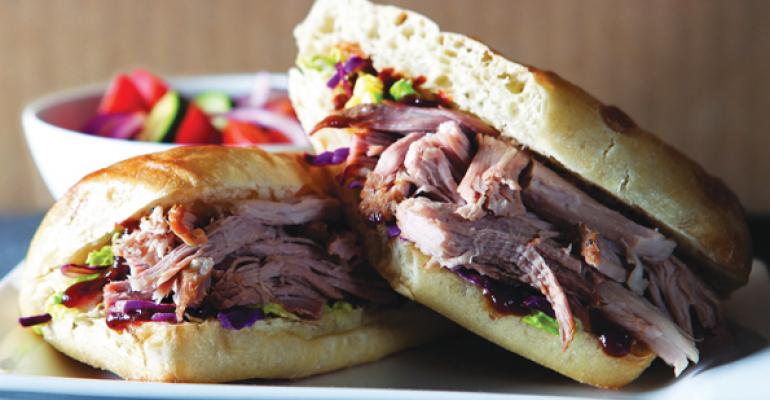Two years ago, when Noodles & Company was hunting for a new protein to help broaden its menu lineup, it made the decision to go with pork, a meat once considered less desirable than beef and less healthful than chicken or fish. But in recent years “the other white meat” had achieved a level of popularity with consumers that was not lost on the 314-unit fast-casual chain.
“Pork was a protein we knew had strong global appeal, and I have to admit, we like it a lot here,” said Tessa Stamper, director of culinary for Noodles & Company, the recipient of the 2013 MenuMasters Award for Menu/Line Extension.
The Broomfield, Colo.-based chain also recognized pork’s wide range of possible applications.
MULTIMEDIA
Noodles & Co.: We threw a party for pork

RELATED
• R&D tips for creating a successful product launch
• Beverage menu best practices
• See all MenuMasters winners
“We didn’t want to lock ourselves into one cuisine or flavor; we wanted a protein that could cross-function in multiple menu categories. Pork has that versatility,” Stamper said.
While Noodles & Company’s R&D team already had plans for some pork-centric limited-time offers and premium add-ons to existing menu items, it still needed to find a particular cut that could be used in a variety of applications. The team decided to go with the “cushion,” a 2- to 3-pound portion of meat taken from the rear of a hog’s picnic shoulder.
The lean muscle is “like the triceps on a human arm,” Stamper said, adding that it’s also affordable and tender.
The chain also believed customers would want meat harvested from hogs that were raised without hormones or antibiotics and were fed a vegetarian diet.
“We’re in a Food Network world now, and people are very conscious of such things,” said marketing director Holly Wagstaff-Bellomo.
After tasting “a whole lot of vendor samples,” Stamper chose a product that arrives at restaurants precooked.
“I’m from the South, where we like to cook our pork slow and low,” said Stamper, describing the vendor’s roasting process. Seasoned first with a rub of salt, pepper, oregano and thyme, the muscle is seared at a high temperature to caramelize the exterior for flavor, and then slow roasted for an extended period.
“We wanted it to be as moist as possible, so we specified that it be cooked in its own juices,” she said.
Sales meet expectations
Continued from page 1
Getting the pork from the ideation phase to cook-line readiness took a year and a half, Stamper said. However, having defined what the chain wanted up front helped guide Noodles & Company to the exact right product, she added.
“We stayed focused on specific flavors and textures to eliminate some of the other options” offered by purveyors, she said.
Once delivered to the restaurant, the meat is pulled apart by hand and heated. When it has been ordered, cooks measure out 3-ounce portions for such items as a Peppery Pork Sandwich on ciabatta bread and a pork-topped macaroni and cheese called Barbecue Pork Mac. The item is also offered as a $2.69 premium add-on for salads and noodle dishes. Though launched as an LTO, the pork sandwich earned a permanent place on the menu and sells for $6.99 with a side of soup or salad.
While Stamper didn’t provide specifics, she said sales of new pork items have met expectations.


“Trying to compare those sales to sales of other proteins on the menu is like apples and oranges,” she said. “We’re just pleased with how well it’s gone.”
Wagstaff-Bellomo said Noodles & Company’s e-club fans got first notice of the new items, and the chain also used social media to support the rollout.
“We teased it, talked about it, had a fun contest around it and invited people in to taste it at [invite-only] events,” she said.
She said merchandising was “very image heavy to show how good it looks,” but that broadcast TV advertising wasn’t part of the chain’s marketing strategy.
“We focus on local-store marketing and teach our general managers about our products at the ground level,” Wagstaff-Bellomo said. “We had a really fun time doing lots of grassroots marketing for this.”
Asked whether popular programs such as this demonstrate that pork is officially beyond its second-choice protein status, Michael Whiteman, president of Baum + Whiteman International Food and Restaurant Consultants, replied in the affirmative.
“There’s been a reversal of the consumer mind-set that said we had to avoid anything that might be bad for our health,” said Whiteman, whose firm is based in Brooklyn, N.Y. “It’s comfort food, which is the kind of food that leaves this wonderful mouthfeel.”
Whiteman said he also believes pork’s resurgent popularity is being driven in part by younger diners not raised with any negative notions about its nutritional impact.
“The younger people have developed a taste for adventure in their eating, and they’re far more eager to eat these kinds of foods,” he said. “Once people discover fatty food feels good in your mouth and tastes good, they begin to explore things that once were neglected. It’s as if there are new taste rules for people who were bored by the same old, same old, [which was] forced on them by restaurant chains that only copycat each other.”





